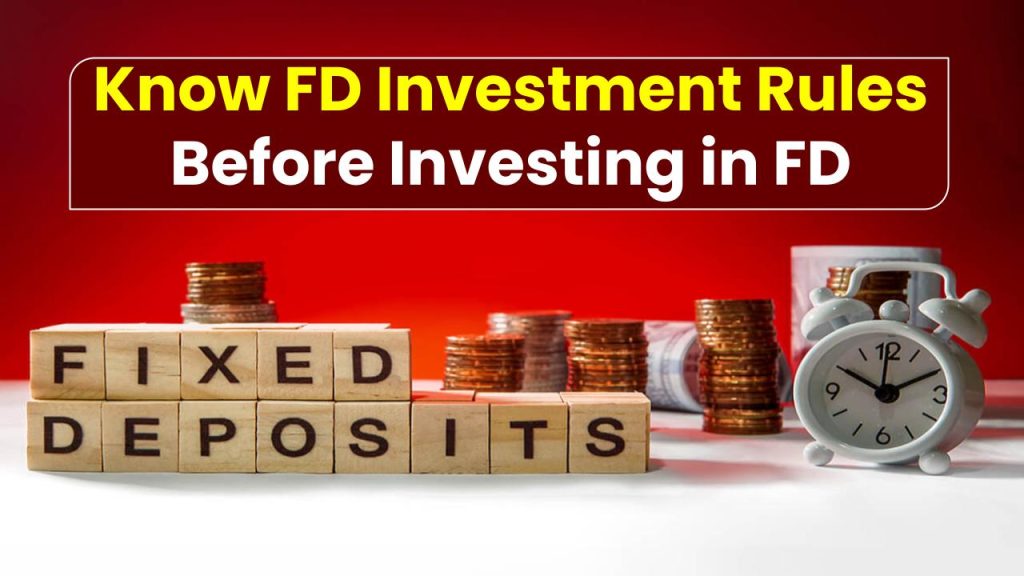
When you walk into a bank to open a Fixed Deposit (FD), everything sounds rosy. Guaranteed returns, safety, and peace of mind — what’s not to love, right? But here’s the catch: there are critical FD investment rules that bankers often don’t reveal upfront. If you don’t know these, your investment may not work as hard as it should for you.
FD Investment Rules
| Topic | Details |
|---|---|
| FD Penalty Rule | Premature withdrawal can attract a penalty of up to 1% on the interest rate |
| Tax on Interest | FD interest is fully taxable under your income slab — up to 30% or more |
| TDS Deduction | TDS is deducted if interest exceeds ₹40,000 (₹50,000 for seniors) |
| Inflation Impact | Real returns may be low if inflation > FD interest rate |
| Insurance Limit | DICGC insures deposits only up to ₹5 lakh per bank |
Fixed Deposits are safe and easy-to-understand investments, but they come with caveats that most banks won’t tell you. Understanding these 5 hidden FD rules — from penalties to taxation to inflation — can protect your money and help you earn smarter.
What is a Fixed Deposit (FD)?
A Fixed Deposit, or FD, is a financial tool offered by banks and post offices where you invest a sum of money for a fixed period and earn a pre-decided interest rate. It’s considered a safe investment, especially for senior citizens and conservative investors. Unlike stocks or mutual funds, an FD does not fluctuate with market trends. However, that doesn’t mean it’s foolproof.
see also: ₹35,000 Loan Interest Rate: Get a Loan for Just ₹3,150
1. Premature Withdrawal Penalty — The Hidden Fine Print
Let’s say you invested ₹1 lakh for 5 years at an interest rate of 7.5% per annum. But two years later, you need the money urgently. Here’s the problem:
- Banks may charge a penalty of 0.5% to 1% on the promised interest rate.
- Your new effective interest rate could drop to 6.5% or less.
Example: If your 2-year FD rate was 6.5% and the bank imposes a 1% penalty, you only get 5.5%. Over ₹1 lakh, that’s a difference of nearly ₹2,000!
Tip: Before investing, ask for the bank’s premature withdrawal policy in writing.
2. Interest on FD Investment is Fully Taxable
This is where most people get surprised. The interest you earn is not tax-free — it’s added to your total taxable income.
- If you earn ₹50,000 in FD interest and fall in the 30% tax bracket, you lose ₹15,000 to tax.
- That brings your net return down from 7.5% to about 5.25% after tax.
Tip: Consider investing in tax-saving FDs under Section 80C (with a 5-year lock-in), or opt for FDs in the name of a non-taxpayer spouse or senior citizen to reduce the tax burden.
3. TDS Deductions Can Eat Into Your Returns
TDS (Tax Deducted at Source) applies if your FD interest exceeds a threshold:
- ₹40,000 for regular citizens
- ₹50,000 for senior citizens
If you don’t submit Form 15G/15H, banks will deduct 10% TDS. Without PAN, the TDS jumps to 20%
Example: If you earn ₹60,000 in FD interest and didn’t submit 15G/H, ₹6,000 could be cut as TDS — and you’ll have to file a refund claim later.
Tip: Always submit 15G or 15H (available at bank branches or online) if your income is below the taxable limit.
4. Inflation Can Beat Your FD Returns
This is a silent killer. Let’s break it down:
- Suppose you earn 7% from an FD.
- Inflation is at 6.5%.
Your real return is just 0.5% — not great.
Now imagine if inflation rises to 7.5%, you are effectively losing money in real terms.
Tip: If your goal is long-term (10+ years), mix FDs with mutual funds or inflation-indexed bonds to protect your capital.
5. Your FD is Only Safe Up to ₹5 Lakh
Here’s something most people overlook. Only ₹5 lakh per depositor per bank is insured under DICGC (Deposit Insurance and Credit Guarantee Corporation).
That includes:
- Principal + Interest
- Across all accounts (savings, current, FDs)
If the bank collapses (like PMC Bank did), and your total deposit is ₹10 lakh, only ₹5 lakh is guaranteed.
Tip: If you have large sums, split your FDs across multiple banks to stay within the insurance limit.
How to Make the Most of Your FD Investment
Here’s a step-by-step guide for smart FD Investment:
Step 1: Compare FD Rates
Use bank portals or platforms like:
- BankBazaar FD Calculator
- RBI’s list of authorized banks
Step 2: Choose the Right Tenure
Match the FD period to your goal:
- Short-term needs? Opt for 6 months to 1 year
- Long-term goals? Use 5-year tax-saving FDs
Step 3: Know the Interest Payout Option
Choose between:
- Cumulative FD: Interest is paid at maturity
- Non-Cumulative FD: Interest paid monthly/quarterly — great for retirees
Step 4: Consider Laddering
Instead of putting ₹5 lakh in one FD, divide it into:
- ₹1 lakh for 1 year
- ₹1 lakh for 2 years
- ₹1 lakh for 3 years
…and so on.
This FD laddering strategy helps you get periodic liquidity and higher returns as interest rates rise.
Step 5: Reinvest Smartly
At maturity, don’t automatically renew. Compare new rates — you might find better offers from other banks or financial institutions.
see also: Post Office Scheme: This Scheme Gives Fixed Interest Every Month
FD Investment Rules FAQs
Q1. What is the minimum amount to start an FD?
You can open an FD with as little as ₹1,000 in most banks and post offices.
Q2. Can I break an FD before maturity?
Yes, but you may face a penalty and lower interest rate depending on the bank’s policy.
Q3. Is FD interest better than savings account?
Yes, FD interest is usually higher (6%–8%) compared to savings accounts (2.5%–4%).
Q4. How do I avoid TDS on FD Investment?
Submit Form 15G or 15H if your annual income is below the taxable limit.
Q5. Are company FDs safe?
They offer higher interest but come with credit risk. Check their CRISIL or ICRA rating before investing.











